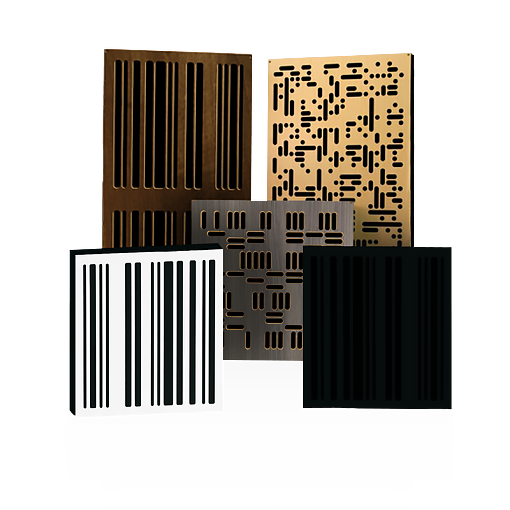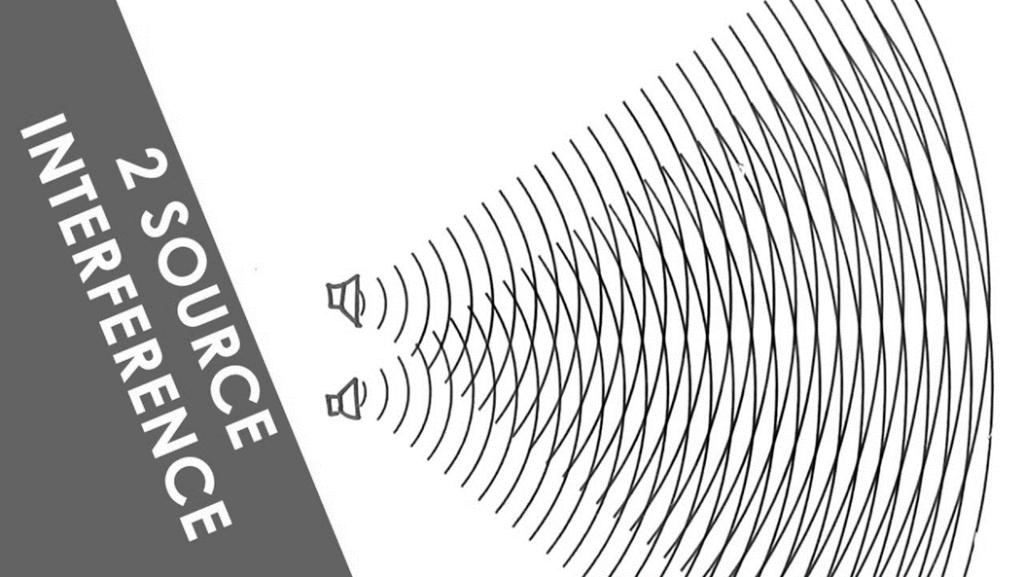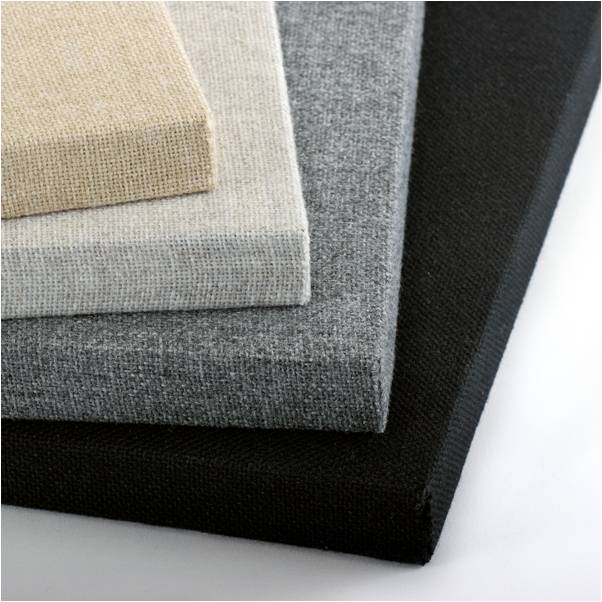When it comes to sound quality, when every update appears to include deciphering the complexities of connector kinds and sophisticated formatting regulations, it’s refreshing to discover an item of gear that may enhance your system without requiring you to plug it in. Acoustic panels, for example, can make a significant difference.
Acoustic panels improve the audio quality of your present speakers by reducing the number of sound waves deflected off the walls. If they’re arranged correctly, they can be incredibly effective with just a few panels.
Acoustic panels are the ideal instrument for the job if you’re establishing a home theater, doing any kind of audio recording of music (or maybe for a podcast), or simply attempting to figure out if there’s an alternative to handle a noisy office setting. Let’s take a closer look at the issue.

The Issue: There Are Too Many Sound Waves
If you’ve ever heard the distinction between inexpensive speakers and even a reasonably priced soundbar or surround sound audio system, you’ll understand how important good speakers are. It’s one of the best audio purchases you can make, particularly if you’re considering a room as a home theater. However, installing more speakers has one unanticipated repercussion: you now have more sound waves to cope with.
You’ll have a lot more sound waves travelling through the air than you ever had before, especially if you’ve invested in a system with multiple speakers directed in different directions. The only issue is that when sound waves in the air collide, they influence those waves, moving and changing them.
What Happens When Sound Waves Collide?
In most cases, the effect of waves crossing is negligible. After all, if you’re talking with someone else at the same time, you can still hear each other and comprehend what they’re saying, but if you add another couple of people, it’s difficult to grasp what’s going on.
When huge speaker systems are used, all of the speakers fire at the same time, making it sound like one person is speaking, but when the sound waves continue to travel, they strike the walls and bounce off.
The waves are then projected back into the room, while the speakers continue to fire: it’s as if two individuals are conversing at the same time. The noises then continue to bounce off each other, and the sound quickly becomes a mash-up of all the reflections.

The main audio will still be audible, but the clarity will be reduced due to the other sounds bouncing around. It’s possible that your speaker system sounds fantastic at low volumes–after all, it has all those channels–but that turning it up lowers the quality and causes it to sound off.
Likewise, if your objective is to capture music or talk in a peaceful environment with no sounds bouncing around, you’ll need to carefully regulate and absorbed that sound to improve the quality of your recording.
Acoustic Panels: How Do They Reduce Sound Waves?
Sound waves are trapped by acoustic panels, which are formed of foam. They normally have a cloth lining to make them more artistically pleasant, yet in areas like recording studios, where aesthetics aren’t as crucial, you might see some bare panels.
Acoustic panels are made of components that enable sound to pass through but not out, such as thick foam, wool, or acoustically helpful insulating materials like fiberglass or denim. If you’ve ever looked at bare foam panels, you’ll see that some of them have jagged triangle forms cut into the tops. A sound diffuser works slightly different in that it disperses reflected sound waves to reduce echoes – they can be used as a complement to acoustic panels which absorb sound.

These geometric patterns operate as a funnel for sound waves, which bounce back and forth down them before being directed into the foam. When you have acoustic panels properly positioned throughout your area, they capture sound waves in the air after you’ve heard them but before they’ve had an opportunity to bounce off the walls. This is significant because if sound waves are not regulated, they will bounce all over the place, colliding with other waves as mentioned above.
How Effective Are Acoustic Panels?
Acoustic panels are extremely good at controlling sound waves. They immediately attenuate the reflected, undesired sound. However, there are some elements that must be perfect in order and get the most out of acoustic panels.
To begin, you’ll need thick enough panels to absorb all of the noise. Take note of the following two examples: The ATS Acoustic Panel (from Amazon) is made up of 2 foot wide, 4 foot tall, and 2 inch deep panels. Another alternative is the ADW Acoustic Panels (on Amazon), which are made up of many 1 inch deep panels of various sizes.
Putting aside the notion that they are different rectangle sizes (and so have different surface areas), the thickness variation is significant. With their 1-inch thickness, the ADW panels won’t have nearly the same impact. To get the most bang for your buck, we recommend purchasing panels that are at least 2 inches thick.

Then you’ll have to acquire sufficient acoustic panels to make a noticeable effect. However, you don’t need just one, and you almost certainly don’t need three or four. The fundamentals are as follows:
You’ll need at least one acoustic panel per speaker, if not more, to do it perfect. A decent rule of thumb is to make sure that at least 20% of your free wall space is covered. However, if you start with fewer, as long as you place them in the appropriate places, you should be fine.
And, based on the performance you require, bigger amounts like 50-100 percent coverage should be considered for studio-level sound absorption. There are also other types of panels available, such as huge insulated acoustic panels and foam panels.
Types of Acoustic Panels
Art, fabric-wrapped, and perforated acoustic panels are just a few of the options available. Your individual requirements will determine which one is ideal for you.
Art Acoustic Panels
You can soundproof a space without compromising your particular flair with art acoustic panels. They can even be customized to match your unique requirements. In actuality, an acoustic panel professional can help you capture your images and put them on a fabric-wrapped acoustic panel in rich, true-to-life colors using patented DyeFusionTM technology.
Finally, ornamental art acoustic panels are a fantastic solution for a variety of environments, including:
- Bars and restaurants
- Auditoriums
- Gymnasiums
- Conference rooms
- Libraries
- Home and office spaces
- Theaters
- Museums

Art acoustic panels may be the best option for soundproofing a space while also allowing you to go crazy with your décor. An acoustic panel expert can show you a variety of colorful yet effective art acoustic panels, assuring that you won’t have any trouble lowering noise while also adding some creative flair to your room.
Fabric – Wrapped Panels
The acoustic performance of fabric-wrapped panels is unrivaled. They are available in a variety of fabric wrap finishes, sizes, and configurations, allowing for endless creative possibilities.
Fabric-wrapped panels can provide the benefits of professional acoustic equipment. You won’t have to worry about a lengthy installation process because the panels are simple to install on a wall or ceiling. Fabric-wrapped panels are made to order as well, allowing you to acquire high-quality panels for any room at any time.
Fabric-wrapped panels can be taught the ins and outs by an acoustical panel expert. This expert will gladly answer any queries you may have about fabric-wrapped panels or other acoustic goods.

Perforated – Acoustic Wood Panels
Perforated acoustic wood panels lower speaker and musician noise levels, as well as sound reverberations within a building. The panels feature dents on them to help absorb and focus soundwaves, and they can be suspended from the ceiling to reduce noise and echo.
Acoustic wood panels with perforations have a number of advantages, including:
- Superior Sound Absorption: The panels absorb and diffuse sound, making a space quieter.
- Additional Seclusion: The panels can be used to give an area more privacy and intimacy.
- Improved Sound Quality: The panels can help you improve the quality of your listening and recording as well as speech intelligibility.

You’ll need to consider all of your acoustical panel alternatives while looking for the perfect panels for a commercial or home project. Fortunately, acoustic panel professionals can help you discover the perfect acoustical panels without the guessing.
Materials Used to Make Acoustic Panels
There are a variety of materials that firms utilize to create soundproofing items, but some are used more frequently than others due to their budget point and features.
The cost of a soundproof panel is mostly determined by the materials used, so it’s helpful to know which are the greatest. Better materials, as you might guess, mean better soundproofing, and greater soundproofing equals more money. When deciding which material to use for your panels, think about how much noise you need to block out and whether you are willing to pay extra for higher quality.
Let’s take a look at the three most common materials used to make soundproof panels.
Fabric
When placed over other, more effective materials, fabric is one of the greatest components for soundproof panels; nevertheless, fabric by itself will not do much to block out sound.
Fabric’s advantages include its many varied colors, sizes, and varieties, allowing it to be used for a variety of purposes.
Overall, fabric is not a soundproofing material that should be used.
Perforated Wood
Perforated wood is an excellent material for those who value durability and eco-friendly activities.
Wood, of course, comes in a variety of sorts, forms, and sizes, and may be customized to meet your space and décor. Wood is a good soundproofing material, but not the greatest.
Foam
Foam is the greatest material for soundproof panels, which is why it is one of the most widely used soundproofing materials.
Foam is not only inexpensive, but also effective, simple to install, and lightweight, making it easy for suppliers to distribute. Although soundproof panels will not perform as effectively as more expensive soundproofing choices, they will undoubtedly aid in the reduction of unwanted noise entering and exiting your space.
Placement Matters
When you consider the sound waves that leave the speaker, it’s obvious that they’ll be focused at you–the listener–but the issue is on the other side of you: when the sounds from the speaker go on and bounce off the wall. To obtain the optimum results, you’ll need to place acoustic panels where the majority of the sound is bouncing.
To collect sound from front-firing speakers, you’ll probably need several panels on the wall behind your arrangement. If you’ve installed two channels of surround sound behind a viewing area, those sounds will almost certainly require at least two acoustic panels, one for each speaker, at the front of the room. And these can most likely be positioned on the room’s sidewalls at the corner.
Next, get a bass trap and place it in one of the corners if you have a subwoofer, or perhaps two. Because bass sound waves are less directed, the bass trap can be placed in any corner.
Then, wherever you believe is best, you can add more panels to make the room sound better, but keep in mind where the sound is actually bouncing from. Rather than scattering panels, it makes more sense to cluster them across from speakers.
If your sound system is so large that it takes up too much wall space, consider installing acoustic panels on the ceiling to absorb all of the bouncing waves. You’ll want to acquire as much coverage as possible if you’re trying to furnish a music studio or a podcast recording studio.
Conclusion
It’s obvious that acoustic panels can help you manage sound waves in your environment. They can help you get the most out of that high-tech stereo speaker system, or ensure that your music and audio recordings are crystal clear. However, there are a few things that must be correct.
Make sure the acoustic panels you purchase are thick enough and that you have enough of them to cover all of the necessary areas for your setup. After that, you may need to install a few more to ensure that your space’s acoustics are under control. More isn’t always better, but in the case of acoustic panels, it usually is.
If you’re a dedicated do-it-yourselfer, you should know that you may easily construct your own panels with the correct insulation and textiles.
You may also be interested in:
- What Are Sound Diffusers?
- The Best Home Theater Room Size & Dimension
- Ideal Speaker Placement – The Definitive Guide
